clock CHEVROLET CAMARO 2002 4.G User Guide
[x] Cancel search | Manufacturer: CHEVROLET, Model Year: 2002, Model line: CAMARO, Model: CHEVROLET CAMARO 2002 4.GPages: 356, PDF Size: 2.56 MB
Page 183 of 356

4-12 Steering in Emergencies
There are times when steering can be more effective
than braking. For example, you come over a hill and
find a truck stopped in your lane, or a car suddenly pulls
out from nowhere, or a child darts out from between
parked cars and stops right in front of you. You can
avoid these problems by braking
-- if you can stop
in time. But sometimes you can't; there isn't room.
That's the time for evasive action
-- steering around
the problem.
Your vehicle can perform very well in emergencies
like these. First apply your brakes. See ªBraking in
Emergenciesº earlier in this section. It is better to
remove as much speed as you can from a possible
collision. Then steer around the problem, to the left
or right depending on the space available.
An emergency like this requires close attention and a
quick decision. If you are holding the steering wheel at
the recommended 9 and 3 o'clock positions, you can
turn it a full 180 degrees very quickly without removing
either hand. But you have to act fast, steer quickly,
and just as quickly straighten the wheel once you have
avoided the object.
The fact that such emergency situations are always
possible is a good reason to practice defensive driving
at all times and wear safety belts properly.
Page 226 of 356

5-16 How to Add Coolant to the Radiator
(3800 V6 Engine Only)
NOTICE:
Your engine has a specific radiator fill procedure.
Failure to follow this procedure could cause your
engine to overheat and be severely damaged.
1. You can remove the radiator pressure cap when
the cooling system, including the radiator pressure
cap and upper radiator hose, is no longer hot.
Turn the pressure cap slowly counterclockwise
until it first stops. (Don't press down while turning
the pressure cap.)
If you hear a hiss, wait for that to stop. A hiss means
there is still some pressure left.
Page 230 of 356

5-20 How to Add Coolant to the Radiator
(V8 Engine Only)
1. You can remove the radiator pressure cap when
the cooling system, including the radiator pressure
cap and upper radiator hose, is no longer hot.
Turn the pressure cap slowly counterclockwise
until it first stops. (Don't press down while turning
the pressure cap.)
If you hear a hiss, wait for that to stop. A hiss means
there is still some pressure left.
2. Then keep turning the pressure cap, but now push
down as you turn it. Remove the pressure cap.
CAUTION:
You can be burned if you spill coolant on hot
engine parts. Coolant contains ethylene glycol,
and it will burn if the engine parts are hot
enough. Don't spill coolant on a hot engine.
Page 234 of 356
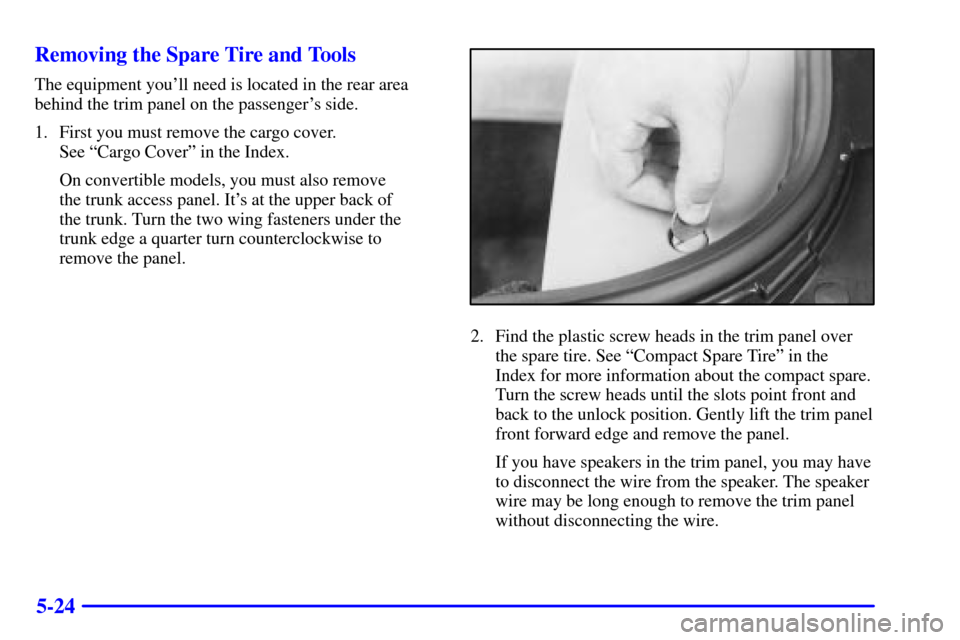
5-24 Removing the Spare Tire and Tools
The equipment you'll need is located in the rear area
behind the trim panel on the passenger's side.
1. First you must remove the cargo cover.
See ªCargo Coverº in the Index.
On convertible models, you must also remove
the trunk access panel. It's at the upper back of
the trunk. Turn the two wing fasteners under the
trunk edge a quarter turn counterclockwise to
remove the panel.
2. Find the plastic screw heads in the trim panel over
the spare tire. See ªCompact Spare Tireº in the
Index for more information about the compact spare.
Turn the screw heads until the slots point front and
back to the unlock position. Gently lift the trim panel
front forward edge and remove the panel.
If you have speakers in the trim panel, you may have
to disconnect the wire from the speaker. The speaker
wire may be long enough to remove the trim panel
without disconnecting the wire.
Page 236 of 356
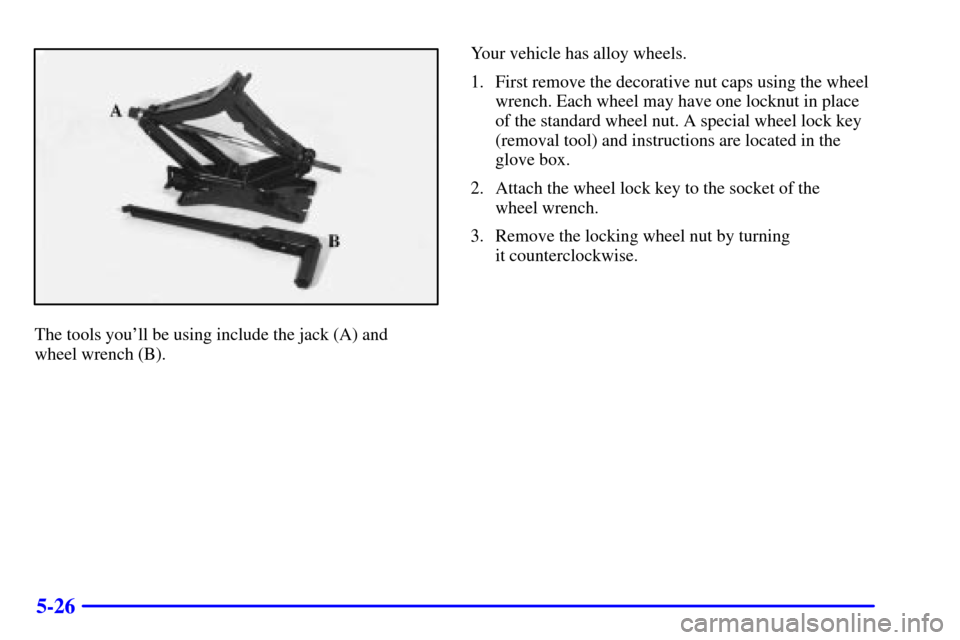
5-26
The tools you'll be using include the jack (A) and
wheel wrench (B).Your vehicle has alloy wheels.
1. First remove the decorative nut caps using the wheel
wrench. Each wheel may have one locknut in place
of the standard wheel nut. A special wheel lock key
(removal tool) and instructions are located in the
glove box.
2. Attach the wheel lock key to the socket of the
wheel wrench.
3. Remove the locking wheel nut by turning
it counterclockwise.
Page 239 of 356
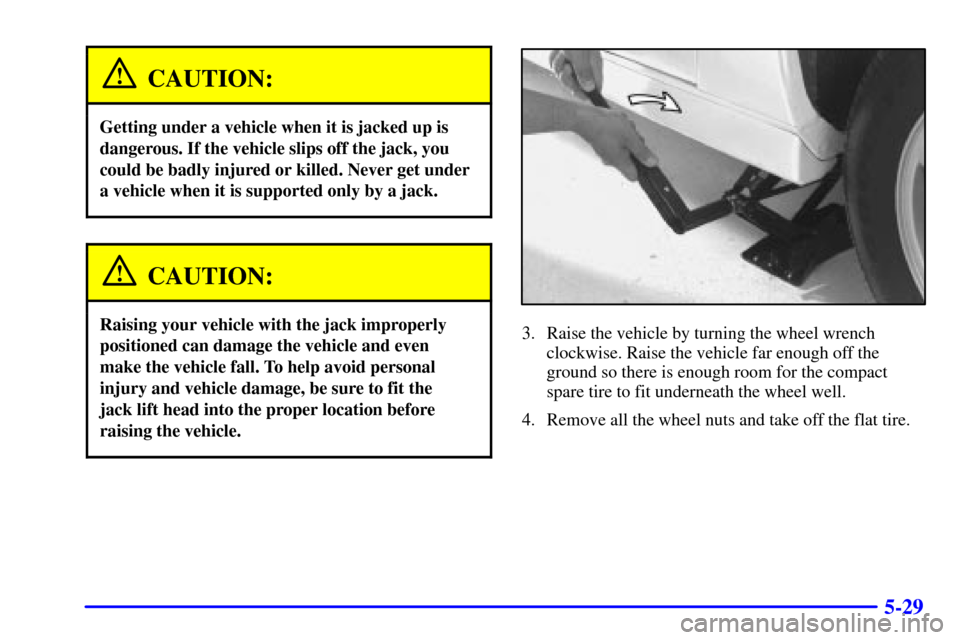
5-29
CAUTION:
Getting under a vehicle when it is jacked up is
dangerous. If the vehicle slips off the jack, you
could be badly injured or killed. Never get under
a vehicle when it is supported only by a jack.
CAUTION:
Raising your vehicle with the jack improperly
positioned can damage the vehicle and even
make the vehicle fall. To help avoid personal
injury and vehicle damage, be sure to fit the
jack lift head into the proper location before
raising the vehicle.3. Raise the vehicle by turning the wheel wrench
clockwise. Raise the vehicle far enough off the
ground so there is enough room for the compact
spare tire to fit underneath the wheel well.
4. Remove all the wheel nuts and take off the flat tire.
Page 241 of 356
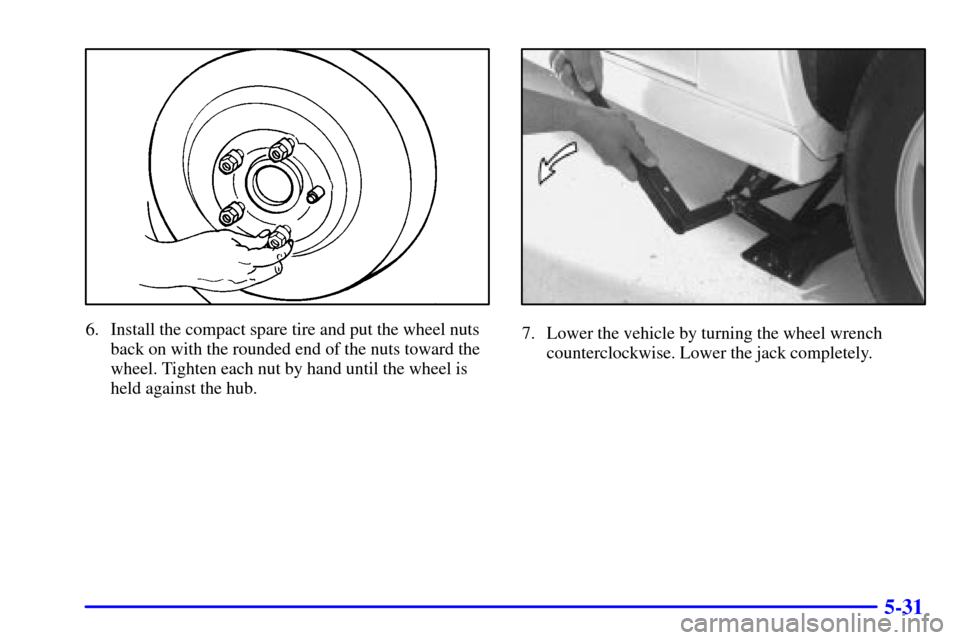
5-31
6. Install the compact spare tire and put the wheel nuts
back on with the rounded end of the nuts toward the
wheel. Tighten each nut by hand until the wheel is
held against the hub.7. Lower the vehicle by turning the wheel wrench
counterclockwise. Lower the jack completely.
Page 252 of 356
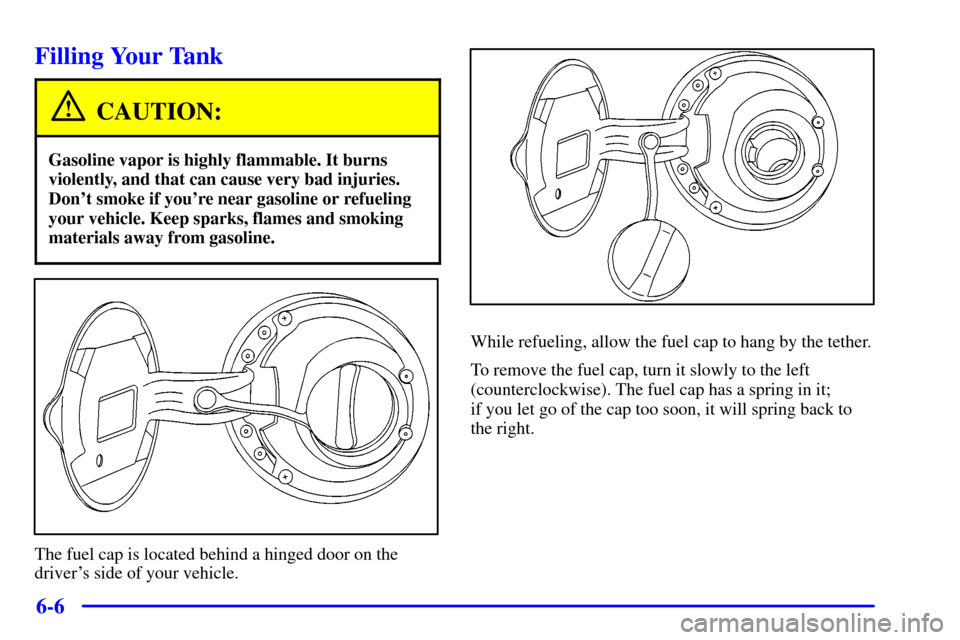
6-6
Filling Your Tank
CAUTION:
Gasoline vapor is highly flammable. It burns
violently, and that can cause very bad injuries.
Don't smoke if you're near gasoline or refueling
your vehicle. Keep sparks, flames and smoking
materials away from gasoline.
The fuel cap is located behind a hinged door on the
driver's side of your vehicle.
While refueling, allow the fuel cap to hang by the tether.
To remove the fuel cap, turn it slowly to the left
(counterclockwise). The fuel cap has a spring in it;
if you let go of the cap too soon, it will spring back to
the right.
Page 253 of 356
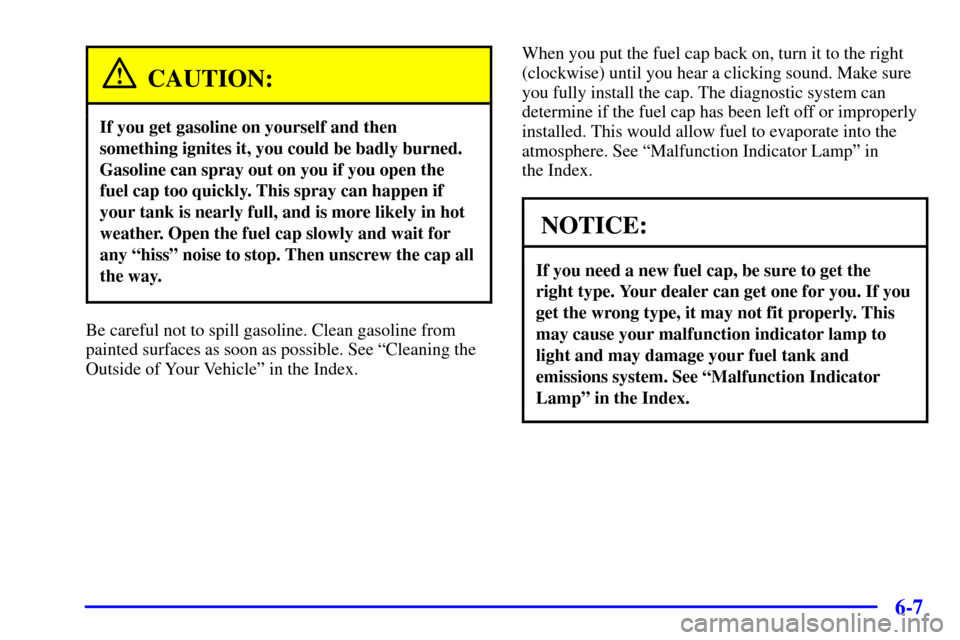
6-7
CAUTION:
If you get gasoline on yourself and then
something ignites it, you could be badly burned.
Gasoline can spray out on you if you open the
fuel cap too quickly. This spray can happen if
your tank is nearly full, and is more likely in hot
weather. Open the fuel cap slowly and wait for
any ªhissº noise to stop. Then unscrew the cap all
the way.
Be careful not to spill gasoline. Clean gasoline from
painted surfaces as soon as possible. See ªCleaning the
Outside of Your Vehicleº in the Index.When you put the fuel cap back on, turn it to the right
(clockwise) until you hear a clicking sound. Make sure
you fully install the cap. The diagnostic system can
determine if the fuel cap has been left off or improperly
installed. This would allow fuel to evaporate into the
atmosphere. See ªMalfunction Indicator Lampº in
the Index.
NOTICE:
If you need a new fuel cap, be sure to get the
right type. Your dealer can get one for you. If you
get the wrong type, it may not fit properly. This
may cause your malfunction indicator lamp to
light and may damage your fuel tank and
emissions system. See ªMalfunction Indicator
Lampº in the Index.
Page 286 of 356
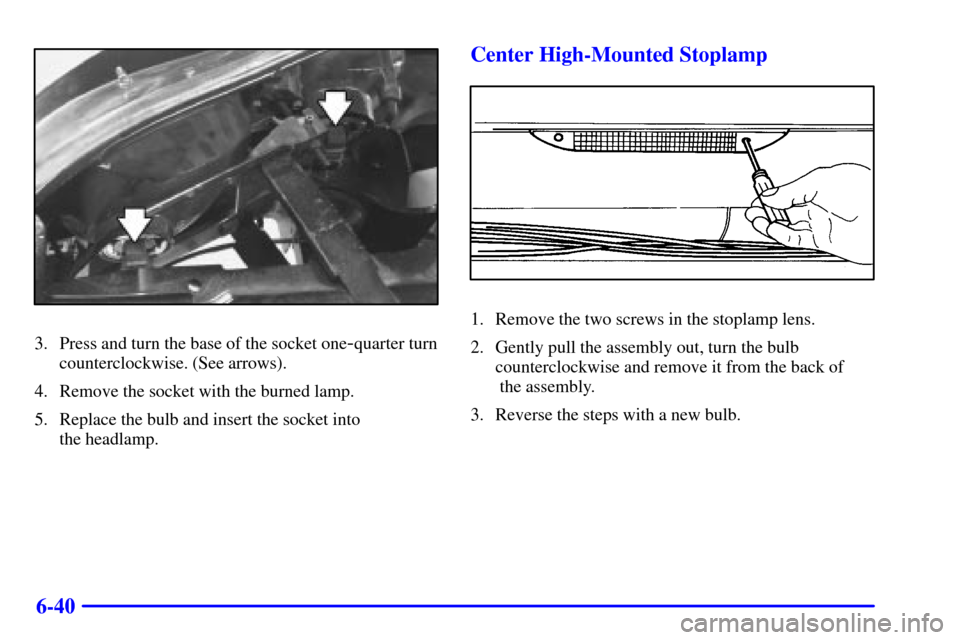
6-40
3. Press and turn the base of the socket one-quarter turn
counterclockwise. (See arrows).
4. Remove the socket with the burned lamp.
5. Replace the bulb and insert the socket into
the headlamp.
Center High-Mounted Stoplamp
1. Remove the two screws in the stoplamp lens.
2. Gently pull the assembly out, turn the bulb
counterclockwise and remove it from the back of
the assembly.
3. Reverse the steps with a new bulb.